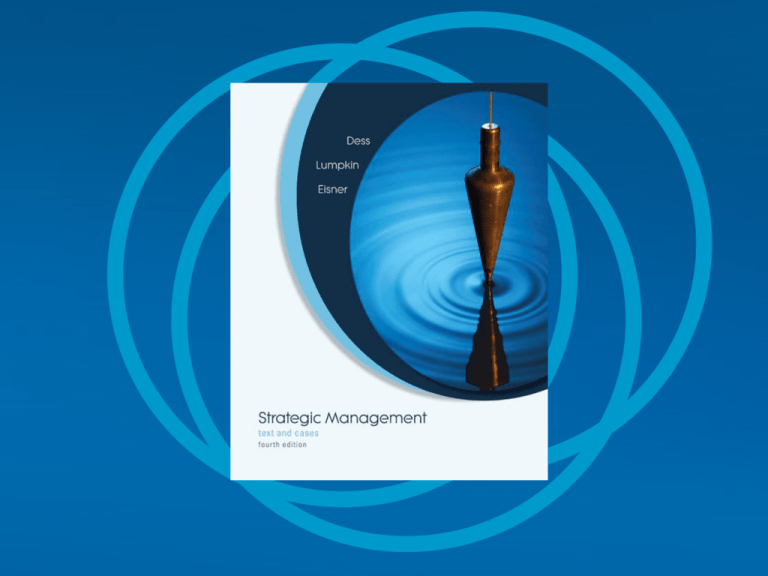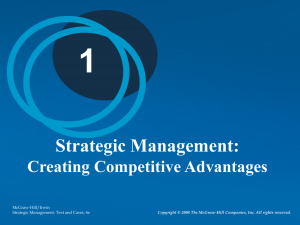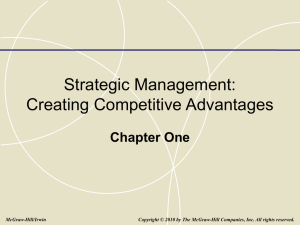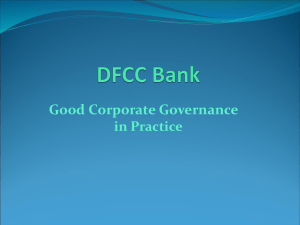
1
Strategic Management:
Creating Competitive Advantages
McGraw-Hill/Irwin
Strategic Management: Text and Cases, 4e
Copyright © 2008 The McGraw-Hill Companies, Inc. All rights reserved.
1-3
Learning Objectives
After reading this chapter, you should have a good
understanding of:
The definition of strategic management and its four key attributes.
The strategic management process and its three interrelated and
principal activities.
The significance of strategic issues
The vital role of corporate governance and stakeholder
management as well as how “symbiosis” can be achieved among
an organization’s stakeholders.
The importance of social responsibility, including environmental
sustainability, and how it can enhance a corporation’s innovation
strategy.
The need for greater empowerment throughout the organization.
How an awareness of a hierarchy of strategic goals can help an
organization achieve coherence in its strategic direction.
1-4
Two Perspectives of Leadership
•
Romantic view
‾
•
Leader is the key force in organization’s success
External control perspective
‾
•
Focus is on external factors that affect an
organization’s success
Leaders can make a difference
‾
‾
Must be aware of opportunities and threats faced in
external environment
Must have thorough understanding of the firm’s
resources and capabilities
1-5
Strategic Management
• Analysis
‾ Strategic goals (vision, mission, strategic objectives)
‾ Internal and external environment of the firm
• Strategic decisions – Strategy Formulation
‾ What industries should we compete in?
‾ How should we compete in those industries?
• Actions – Strategy Implementation
‾ Allocate necessary resources
‾ Design the organization to bring intended strategies to
reality
1-6
Strategic Management
Strategic management is the study of why some
firms outperform others
‾ How to compete in order to create competitive
advantages in the marketplace
‾ How to create competitive advantages in the market
place
o Unique and valuable
o Difficult for competitors to copy or substitute
In short, strategic management is about how an
organization adds value and competes in its environment.
1-7
Key Attributes
Key Attributes of strategic management:
• Directs the organization toward overall goals and
objectives
• Includes multiple stakeholders in decision making
• Needs to incorporate short-term and long-term
perspectives
• Recognizes trade-offs between efficiency and
effectiveness
1-8
Question
• The final realized strategy of a firm is a
combination of:
a)
b)
c)
d)
Intended and unrealized strategies
Unrealized and emergent strategies
Emergent and deliberate strategies
Deliberate and unrealized strategies
1-9
Strategic Management Process
Adapted from Exhibit 1.2 Realized Strategy and Intended Strategy: Usually Not the Same
Source: H. Mintzberg and J. A. Waters, “Of Strategies, Deliberate and Emergent,” Strategic Management Journal 6 (1985), pp. 25772.
1 - 10
Strategic Analysis
• Starting point in the
strategic management
process
• Precedes effective
formulation and
implementation of
strategies
1 - 11
Strategic Analysis (cont.)
• Clear goals and objectives permit effective
allocation of resources
• Hierarchy of goals
- Vision
- Mission
- Strategic objectives
• Analyzing external environments
- Managers must scan the environment and analyze
competitors
- General environment
- Industry environment
1 - 12
Strategic Analysis (cont.)
• Frameworks for analyzing a firm’s internal
environment
- Strengths
- Weaknesses
• Analyzing strengths can uncover potential
sources of competitive advantage
1 - 13
Strategic Analysis (cont.)
• Intellectual assets are drivers of
- Competitive advantage
- Wealth creation
• Networks and relationships among
-
Employees
Customers
Suppliers
Alliance partners
1 - 14
Strategic Issues
• Results from Strategic Analysis
• Strategic issues require top-management
decisions
- Strategic decisions overarch several areas of a
firm’s operations
- Usually only top management has the perspective
needed to understand their broad implications
- Usually only top managers have the power to
authorize necessary resource allocations
1 - 15
Strategic Issues
• Strategic issues require large amounts of
the firm’s resources
- They involve substantial allocations of people,
physical assets, and money
- Strategic decisions commit the firm to actions
over an extended period
- In highly competitive firms, achieving and
maintaining customer satisfaction frequently
involves commitment from every facet of the
firm
1 - 16
Strategic Issues
• Strategic issues often affect the firm’s longterm prosperity
- Strategic decisions commit the firm for a long
time, typically 5 years; however the impact lasts
much longer
- Once a firm has committed itself to a strategy, its
image and competitive advantages are usually
tied to that strategy
- Firms become known for what they do and where
they compete. Shifting away from that can
jeopardize their previous gains.
1 - 17
Strategic Issues
• Strategic issues are future-oriented
- They are based on what managers forecast,
rather than what they know
- Emphasis is on the development of solid
projections that will enable a firm to seek the
most promising strategic options
- A firm will succeed only if it takes a proactive
(anticipatory) stance toward change
1 - 18
Strategic Issues
• Strategic issues usually have
multifunctional or multibusiness
consequences.
- Strategic decisions have complex implications
for most areas of the firm
- Decisions about customer mix, competitive
emphasis, or organizational structure involve a
number of the firm’s SBUs, divisions, or
program units
1 - 19
Strategic Issues
• Strategic issues require considering the
firm’s external environment
- All businesses exist in an open system. They
affect and are affected by external conditions
that are largely beyond their control
- Successful positioning requires that strategic
managers look beyond operations and
consider what relevant others are likely to do
1 - 20
Strategy Formulation
• Business level strategy:
- Successful firms develop bases for competitive
advantage
• Cost leadership
• Differentiation
• Focusing on narrow or industry-wide market segments
- Sustainability
- Industry life cycle
1 - 21
Strategy Formulation (cont.)
Corporate-level strategy addresses:
• Firm’s portfolio, group, mix of businesses
- What business(es) should we be in?
- How can we create synergies among the businesses?
• Diversification
- Related
- Unrelated
1 - 22
Strategy Formulation (cont.)
• International Strategy
- Appropriate entry strategies for foreign markets
- Sustain competitive advantage in global markets
• Effective strategies for entrepreneurial initiatives
1 - 23
Strategy Implementation
• Informational control
- Monitor and scan the environment
- Respond effectively to threats and opportunities
• Behavioral control
• Effective corporate governance
- Interests of managers and owners of the firm
• Organizational structure and design
1 - 24
Strategy Implementation (cont.)
• Organizational boundaries
- Flexible
- Permeable
• Strategic Alliances
• Develop organization that is committed to
- Excellence
- Ethical behavior
1 - 25
Strategy Implementation (cont.)
• Learning organization responsive to
- Rapid and unpredictable change
• Corporate entrepreneurship and innovation
-
New opportunities
Enhance innovative capacity
Autonomous entrepreneurial behavior
Product champions
1 - 26
Corporate Governance and Stakeholder
Management
• Corporate governance: the relationship among
various participants in determining the direction
and performance of corporations
- Shareholders
- Management (led by the CEO)
- Board of Directors
1 - 27
Question
• Briefly describe the role of board of directors in
corporate governance.
1 - 28
Corporate Governance and Stakeholder
Management (cont.)
• Board of Directors
- Elected representatives of the
owners
- Ensure interests and motives
of management are aligned
with those of the owners
• Effective and engaged Board
of Directors
• Shareholder activism
• Proper managerial rewards
and incentives
1 - 29
Example: New Rules for Directors
In light of numerous corporate scandals, the role
and rules for board of directors are being
redefined. Few areas of focus :
-
Numbers Knowledge
Strategy Focus
Time & Understanding
Watchdog
Source: Tipsheet, Business Week, January 22, 2007
1 - 30
Stakeholder Management
• Two views of stakeholder management
- Zero sum
• Stakeholders compete for attention and resources of
the organization
• Gain of one is a loss to the other
- Symbiosis
• Stakeholders are dependent upon each other
• Mutual benefits
1 - 31
Social Responsibility
• Social responsibility: the expectation that
businesses or individuals will strive to improve
the overall welfare of society
‾ Managers must take active steps to make society
better
‾ Socially responsible behavior changes over time
‾ Triple bottom line
1 - 32
Example: Social Responsibility
Starbucks Coffee Company
Corporate social responsibility is embedded
throughout the organization.
The following are some of the commitments they have
made to be socially responsible:
•
•
•
•
Commitment to origins
Helping protect the environment
Starbucks in your community
Commitment to partners
Source: www.starbucks.com
1 - 33
Strategic Management Perspective
• Integrative view of the organization
• Assess how functional areas and activities “fit
together” to achieve goals and objectives
• All managers and employees must take an
integrative, strategic perspective on issues facing
the organization
1 - 34
Enhancing Employee Involvement
Local Line
Leaders
• Have significant profit and loss
responsibility
1 - 35
Enhancing Employee Involvement
Local Line
Leaders
Executive
Leaders
• Champion and guide
ideas
• Create a learning
infrastructure
• Establish a domain for
taking action
1 - 36
Enhancing Employee Involvement
Local Line
Leaders
Executive
Leaders
Internal
Networkers
• Have little positional
power and formal
authority
• Generate their power
through the conviction
and clarity of their ideas
1 - 37
Modern Flow of Strategic
Management
Top Management
Subsidiary
Management
Functional
Management
Operating Management
Employees
1 - 38
Why Modern Flow of Strategic
Management?
Changes in and heightened competition
driven by
- Pressure for low cost products and services
- Higher quality requirements
- Globalization
- Increasing rate of technological change and
diffusion
- Information technology
- Knowledge as an organizational resource
1 - 39
Coherence in Strategic Direction
• Company vision
-
Massively inspiring
Overarching
Long-term
Driven by and evokes
passion
- Fundamental statement
of the organization’s
• Values
• Aspiration
• Goals
Company vision
Hierarchy of Goals
1 - 40
Coherence in Strategic Direction
• Mission statements
- Purpose of the company
- Basis of competition and
competitive advantages
- More specific than vision
- Focused on the means
by which the firm will
compete
Company vision
Mission statements
Hierarchy of Goals
1 - 41
Coherence in Strategic Direction
• Strategic objectives
- Operationalize the
mission statement
- Provide guidance on
how the organization can
fulfill or move toward the
“higher goals”
- More specific
- Cover a more welldefined time frame
Company vision
Mission statements
Strategic objectives
Hierarchy of Goals
1 - 42
Coherence in Strategic Direction
• Strategic objectives
-
Measurable
Specific
Appropriate
Realistic
Timely
Challenging
Resolve conflicts that
arise
- Yardstick for rewards
and incentives
Company vision
Mission statements
Strategic objectives
Hierarchy of Goals












